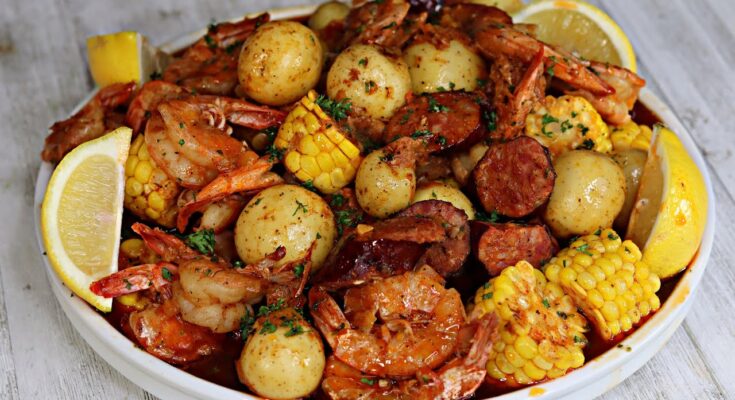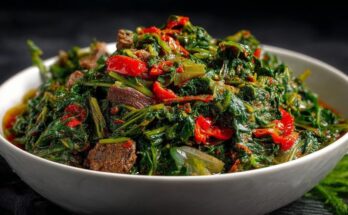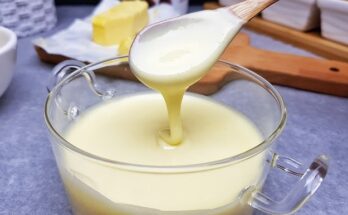Crawfish Boil Recipe: A crawfish boil isn’t just about feeding your belly—it’s a full-blown social event, a backyard festival, and a deep dive into Southern hospitality. Originating in Louisiana, the crawfish boil is a spicy, savory, and sometimes messy tradition that brings people together like few other meals can. Imagine a long table covered in newspaper, friends and family shoulder-to-shoulder, digging into heaps of steaming crawfish, potatoes, and corn. Sounds perfect, right?
This guide will walk you through everything you need to know, from selecting the best crawfish to serving them up hot and juicy. Whether you’re a newbie or looking to refine your technique, this step-by-step guide ensures you boil like a pro.
A Southern Tradition With a Twist
Over the years, crawfish boils have evolved. People add their personal flair—some throw in smoked sausage, others spike the boil with oranges or hot sauce. There’s no one “right” way, and that’s the beauty of it. What matters is bold flavor, good company, and plenty of napkins.
Ingredients You’ll Need
Crawfish Selection Tips
When it comes to a successful boil, the quality of your crawfish can make or break the whole experience. Look for live, feisty crawfish—avoid any that are sluggish or floating. You’ll typically need about 3-5 pounds per person depending on appetites and sides.
If you’re not near the Gulf Coast, you can still score good crawfish from seafood markets or online suppliers that ship live crawfish directly. Just make sure they arrive alive and keep them cool (but not too cold) until you’re ready to start.
Essential Spices and Seasonings
This is where the magic happens. Your boil needs to pack a punch, and that comes from seasoning. While you can use pre-mixed boil seasonings like Zatarain’s or Louisiana Fish Fry, many seasoned hosts mix their own. Here’s what you’ll need:
- 1-2 cups of crawfish boil seasoning
- 1/4 cup cayenne pepper (more if you like it hot)
- 1/4 cup garlic powder
- 1/4 cup onion powder
- 3 lemons, halved
- 3-5 bay leaves
- 1/2 cup salt
Don’t be shy with spices—the boil water should be so flavorful it makes your eyes water a bit.
Vegetables and Add-ons
Classic crawfish boils include:
- Red potatoes (small, whole)
- Corn on the cob (halved)
- Andouille sausage or smoked sausage (cut into chunks)
- Garlic bulbs (halved)
- Mushrooms (optional, but soak up flavors beautifully)
- Whole onions
You can also add extras like artichokes, pineapple chunks, or even Brussels sprouts. It’s your boil—get creative!
Equipment Checklist
Must-Have Tools for a Crawfish Boil
You don’t need a fancy kitchen to host a great boil, but some key tools make it easier. Here’s what you’ll need:
- A large stockpot (at least 60-80 quarts for a big crowd)
- Propane burner (sturdy and safe)
- A long-handled paddle or spoon for stirring
- Crawfish strainer basket (for easy removal from boiling water)
- Ice chests for keeping crawfish cool and then for purging
- Long table and newspapers (for the feast)
A thermometer helps too, but many pros go by instinct—when it smells right and steams right, it’s go time.
Optional Equipment to Elevate Your Game
If you want to up your boil game, consider these extras:
- A second pot for boiling sides separately
- Crawfish table with a center hole for trash
- Seasoning injectors (great for sausage or even corn)
- Gloves for handling spicy crawfish without burning your fingers
Preparing the Crawfish
How to Clean and Purge Crawfish
Before cooking, purging your crawfish is key. This removes mud, debris, and any unpleasant flavors. Here’s how to do it right:
- Place the live crawfish in an ice chest or kiddie pool.
- Rinse with fresh water and drain—repeat until water runs clear.
- Optional: Add 1/4 cup salt, stir gently, and let sit for 5-10 minutes, then rinse again. (Note: Some argue salt-purging isn’t necessary, but it can help.)
Keep them cool and shaded until you’re ready to cook. Never boil dead crawfish—they can make you sick and ruin the batch.
Why This Step is Crucial for Flavor
Think of it like marinating meat or washing veggies—you wouldn’t cook a steak without trimming it, right? Purging is that step for crawfish. It ensures you’re getting sweet, tender meat, not gritty or bitter bites. Plus, clean crawfish make a cleaner boil—your broth won’t be muddy or cloudy, and the final result will look and taste better.
Setting Up the Boil
How to Layer Flavors in the Pot
Timing and layering are everything in a good boil. Here’s a basic order that works:
- Fill your pot about 2/3 full of water, light the burner, and bring to a boil.
- Add seasoning mix, garlic, bay leaves, lemons (squeezed and dropped in), and salt. Let this simmer for 10-15 minutes to infuse.
- Start with potatoes—they take the longest.
- After 10 minutes, add onions, garlic, and sausage.
- After another 5-7 minutes, toss in corn and mushrooms.
- Finally, add the crawfish and bring back to a boil. Once boiling, turn off heat and let them soak for 15-30 minutes.
Timing Tips for Perfect Texture
The soak is what sets great crawfish apart from mediocre ones. Letting them sit in the hot, seasoned broth after cooking lets them absorb flavor deeply. Keep tasting during the soak until they’re just right. Some like a short soak for tender meat, others want them spicy and let them sit longer.
Serving the Crawfish Boil
Best Practices for Presentation
Once the crawfish are soaked and ready, it’s time for the main event: serving them up hot and juicy. A true crawfish boil doesn’t involve plates or utensils. Instead, cover a long table with newspapers or brown butcher paper and dump the entire pot out in the middle. That’s right—just pour it all out, from crawfish to corn to potatoes. Let everyone gather around and dig in.
Presentation is about vibe more than looks. Stack crawfish high, scatter potatoes and corn around, and place sausage links for easy grabbing. Don’t forget to keep napkins and wet wipes nearby—it’s going to get messy, and that’s part of the fun.
Add some bowls for discarded shells and keep cold drinks within reach. For extra flair, garnish with lemon wedges, fresh parsley, or even whole boiled eggs tossed in the mix. Your guests will be wowed by the rustic, communal style that screams Southern charm.
Dipping Sauces and Side Options
While the crawfish are already packed with flavor, dipping sauces elevate the experience. Here are some crowd favorites:
- Garlic butter sauce: Melted butter with minced garlic, parsley, lemon juice, and a pinch of cayenne.
- Spicy remoulade: A tangy blend of mayo, mustard, horseradish, hot sauce, and Cajun seasoning.
- Classic cocktail sauce: Ketchup, horseradish, lemon, and Worcestershire.
For sides, offer French bread, coleslaw, or a light cucumber salad to balance the richness of the boil.
Cleanup and Storage
How to Tidy Up Without Stress
Let’s be real—after the feast, there’s a mountain of shells, corn husks, and sauce-covered napkins. But cleanup doesn’t have to be a headache. Start by rolling up the newspaper tablecloth, shells and all, and tossing it into a large trash bag. Have a few garbage cans nearby for quick disposal.
Use a hose or buckets of water to rinse down any outdoor area. For pots and gear, soak them in hot, soapy water to loosen spices and oils. A steel brush can help scrub off stuck bits from the pot and strainer.
Storing Leftovers Safely
Crawfish don’t reheat well in the shell—they can become rubbery. If you have leftovers, remove the tails from the shells and store them in airtight containers. Refrigerate within two hours of the boil.
Cooked tails can be used in pasta, gumbo, or fried rice the next day. Don’t forget to refrigerate any leftover veggies or sausage—they make for awesome breakfast hashes.
Troubleshooting Common Mistakes
Avoiding Overcooked Crawfish
One of the biggest rookie mistakes is overcooking. Crawfish only need 3-5 minutes of actual boiling. Any longer and they turn tough. The secret lies in the soak, not extra cook time. Keep a timer handy, and don’t walk away during that crucial boiling phase.
Not Enough Seasoning? Here’s the Fix
If you taste the crawfish after the soak and they’re a little bland, don’t panic. Scoop out some of the broth and reduce it on the stove to concentrate the flavors. Pour it back over the crawfish for a last-minute flavor boost.
Next time, consider layering seasoning not only in the boil water but also sprinkling some over the crawfish after draining them. It helps lock in spice and makes for finger-licking goodness.
Tips to Elevate Your Next Boil
Hosting for a Crowd? Here’s How to Scale
Throwing a boil for 10 or 100? The method stays the same, but quantities and timing change. For large crowds, use multiple pots or boil in batches. You can keep finished batches warm in a cooler lined with foil and newspaper.
Be sure to offer shade, drinks, and casual seating. Crawfish boils are about chilling out and catching up, so make it cozy. Set up music, games, or a playlist to keep the vibe rolling.
Flavor Boosters You Haven’t Tried
Want to wow your guests? Toss in some untraditional items during the boil:
- Whole cloves of roasted garlic
- Orange slices for citrusy zing
- Hot dogs for the kids
- Crawfish boil hot sauce splashed right into the pot
- Crushed crab boil bags for next-level spice
Experiment each time you host. Keep notes of what works so your next boil is even better.
Why Everyone Loves a Crawfish Boil
It’s About More Than Just Food
At the heart of it, a crawfish boil is a celebration. It’s about gathering friends and family, sharing laughs, and diving into a hands-on, delicious mess. Unlike formal dinners, there’s no pressure to impress—just great food and better company.
Crawfish boils build traditions, and every host adds their signature style. Whether it’s the spice mix, the add-ins, or the playlist, each boil is one-of-a-kind. And once you throw one, chances are it’ll become your favorite way to entertain.
Regional Twists and Variations
Louisiana Style vs. Texas Style
Though the essence of a crawfish boil is consistent, regional spins make each version unique. Louisiana-style boils tend to be spicier, richer in herbs and seasonings, and rely heavily on soaking the crawfish to soak up flavor after a quick boil. It’s not uncommon for hosts in New Orleans or Baton Rouge to go heavy on cayenne, garlic, and citrus.
Texas boils, on the other hand, lean toward bold and smoky flavor profiles. You might find jalapeños, beer, and even barbecue sausage tossed into the pot. Texans often serve their crawfish with a variety of dipping sauces and focus on layering heat gradually rather than all at once.
Both versions are mouth-watering, and trying each one is a journey worth taking.
Creative Regional Add-Ins
In Mississippi, don’t be surprised to see corn pudding or hush puppies on the side. Florida boils sometimes mix in shrimp or stone crab claws. Up in the Carolinas, folks might toss in country ham or collard greens. These regional extras show how versatile and customizable a boil can be.
Pairing Drinks with Your Boil
Best Beers and Cocktails to Serve
A cold drink is essential at any crawfish boil—spicy food demands a cool companion. Go for light lagers, pilsners, or wheat beers like Blue Moon or Abita Light. These beers are crisp and won’t overpower the seasoning.
For cocktails, try:
- Spicy Bloody Marys – They match the boil’s boldness.
- Cajun Lemonade – A tangy mix of lemon juice, sugar, and vodka.
- Classic Margaritas – Citrus helps cleanse the palate.
Don’t forget to have non-alcoholic options like sweet tea, lemonade, or infused water on hand.
Hydration Tips
Because of the heat—both from the sun and the spices—remind your guests to stay hydrated. Keep water readily available and encourage breaks between rounds of crawfish cracking.
Crawfish Boil Safety Tips
Handling Live Crawfish Safely
Live crawfish can be feisty. Wear gloves when handling them and avoid getting pinched. Only cook crawfish that are alive and active. If they look limp or smell bad, toss them. A healthy crawfish is one that tries to scuttle away when touched.
Keep crawfish in a cool, ventilated container like an ice chest with the lid slightly open. Avoid storing them in standing water—they’ll drown.
Boil Safety Around Fire and Steam
Propane burners and large pots of boiling water can be dangerous. Set up your station on a flat, non-flammable surface like concrete or dirt. Keep children and pets away from the boil area.
Always use pot holders or heat-resistant gloves when moving the lid or stirring. Steam burns are no joke. Have a fire extinguisher on hand just in case—better safe than sorry.
FAQs about Crawfish Boil Recipe
Q: How long should I boil crawfish?
A: Boil crawfish for about 2–3 minutes after the water returns to a rolling boil, then let them soak off the heat for 20–30 minutes to absorb the seasoning. Adjust soak time depending on how spicy or flavorful you want them.
Q: How much crawfish do I need per person?
A: A good rule of thumb is 3–5 pounds of live crawfish per person. If it’s the main dish, lean toward the higher end.
Q: Can I use frozen crawfish for a boil?
A: While fresh live crawfish are best for a traditional boil, frozen whole crawfish or tails can be used if fresh is unavailable. Just note the texture may be slightly different.
Q: What seasonings are best for a crawfish boil?
A: Use a mix of garlic, onion, lemon, cayenne, paprika, bay leaves, and commercial seafood boil blends like Zatarain’s or Louisiana Crawfish Boil seasoning for maximum flavor.
Q: Can I reuse crawfish boil water?
A: It’s not recommended. The water becomes cloudy and overly starchy, especially with potatoes and corn in the mix. For the best flavor and hygiene, start fresh each time.
Q: What side dishes go with crawfish boil?
A: Popular sides include corn on the cob, red potatoes, sausage, boiled eggs, and crusty French bread. A cold beer or sweet tea is the perfect beverage match.
Q: How do I know when crawfish are done cooking?
A: Crawfish turn bright red when cooked. Their tails should curl tightly when picked up—this is a sign they’re properly cooked and safe to eat.
Q: Can I make a crawfish boil indoors?
A: Yes, use a large pot on the stovetop or an indoor propane burner. Make sure there’s plenty of ventilation, and scale down the quantity to match your indoor setup.
Q: How should I store leftover crawfish?
A: Store leftovers in an airtight container in the refrigerator for up to 2 days. You can also peel the tails and freeze the meat for later use in pasta, etouffée, or jambalaya.
Q: What do I do with crawfish shells after the boil?
A: Discard shells in sealed bags or compost them if local regulations allow. Some people even use the heads to make seafood stock.
Conclusion
There’s nothing quite like the experience of a crawfish boil. It’s part meal, part celebration, and 100% fun. With the right ingredients, tools, and crowd, you’ll be hosting an event that people talk about for years. From choosing fresh crawfish to perfecting your spice blend and setting up a killer spread, every step adds flavor—both literally and figuratively.
Whether you’re in the Deep South or trying this tradition for the first time somewhere else, embrace the spirit of the boil. Make it your own, enjoy the mess, and most of all, savor the joy that comes with sharing great food with even better company.



